Common eye problems
Below are our latest 3D videos for you explaining eye conditions like Macular Degeneration, Glaucoma and Cataracts. We also explain visual conditions such as Short Sight (Myopia), Long Sight (Hyperopia) and Astigmatism. There's information on Soft and Gas Permeable contact lenses, spectacle lenses and lens coating and much more!
Just click on the video you want to view for more information.
 Refractive conditions - Astigmatism In a normal eye, light entering the eye is focussed by the cornea and the lens ... to form a sharp image at the back of the eye on the retina. Astigmatism occurs when the cornea is slightly "rugby ball shaped" The effect of this is that lines of different orientations ... come to a focus at different points in the eye. This results in blurred vision when looking in the distance and reading. The degree and angle of astigmatism can vary from eye to eye. If you have astigmatism you may notice that objects of certain orientations look clearer. |
 Refractive conditions - Hyperopia Normally, light is focussed by the cornea and lens to form a sharp image on the retina. Long-sightedness occurs when the eyeball is slightly too short ... ... so that objects are in focus behind the retina at the back of the eye. This may result in blurred vision when looking in the distance ... and particularly when looking at near objects and reading. When we are young, we overcome long-sightedness by bulging out the lens in the eye. However, as we get older, the lens gets harder and can no longer bulge out enough. Long-sightedness can be corrected by spectacles or contact lenses. |
|
 Refractive conditions - Myopia Normally, light is focussed by the cornea and lens to form a sharp image on the retina. Sometimes the eyeball is too long for the shape of the cornea ... ... so the light comes to a focus before it reaches the retina. As a result, objects in the distance are blurred ... ... although close objects are usually clear. Short-sightedness can be corrected by spectacles or contact lenses. These lenses correct the vision so that distant objects are clear once again. |
 Refractive conditions - Presbyopia To see objects at different distances the eye changes its power - just like a camera lens. In the eye this is achieved by a structure called the crystalline lens. When we are young, the lens is like a sack full of jelly. The lens is attached by very fine fibres to a circular muscle. When this muscle constricts, the lens bulges out and close objects come into focus. As we get older the lens continues to grow and becomes inflexible ... ... and the closest point that we can focus on gradually gets further away. Most people over the age of 45 require glasses for reading. |
|
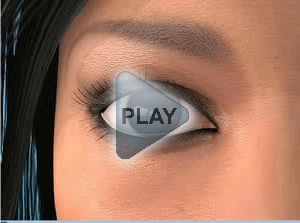 Conditions & diseases - Floaters The eye is filled with a jelly-like substance known as the vitreous. Normally this is clear, but as we get older, debris can accumulate in the jelly. This appears as dots or threads floating across your vision in bright conditions. Floaters are usually of no concern, but if you notice a sudden increase in the number ... ... or if you see flashing lights, you should consult your optometrist immediately. In most cases no treatment is required, but if vision is significantly impaired ... ... the jelly can be replaced with an artificial gel. In some cases floaters can be "removed" using a laser. |
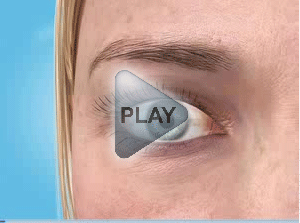 Conditions & Diseases - Vitreous detatchment The eye is filled with a jelly-like substance known as the vitreous. This jelly is loosely attached to the retina at the back of the eye. As we get older, the jelly tends to shrink a little, and can tug on the retina. In some cases the vitreous can detach from the retina. As it tugs on the retina, this can cause flashing lights in the corner of your eye ... ... followed by the appearance of floaters which move across your vision. | |
 Conditions & Diseases - Dry eyes The muscles around the eyes are designed to point both eyes in the same direction. Some people have a condition called a Phoria. Under normal conditions the eyes are straight but if one eye is covered ... ... the eye behind the cover tends to drift out of alignment. The eye can drift in, out, up or down. A large phoria can sometimes cause eye strain and headaches ... ... and in some cases, double vision, particularly when you're tired. Reading can also be difficult and tiring. Phorias can usually be corrected with eye exercises or glasses. |
 Binocular vision disorders - Squint Normally, the two eyes point in the same direction. A "squint" or "strabismus" occurs when the two eyes are misaligned. This can happen in either eye and the misalignment can be in any direction. A squint may occur for a number of reasons. Sometimes, one or more of the muscles that move the eyes is in the wrong place. Sometimes the muscles do not work as they should. A longstanding squint does not usually affect vision ... ... although the squinting eye may be "lazy". A recent squint can result in double vision and should be fully investigated. |
|
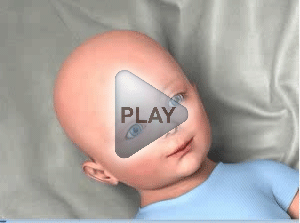 Binocular vision disorders - Amblyopia A squint occurs when the two eye are slightly misaligned. There are a number of things that can be done to help straighten the eyes. Sometimes eye exercises can help ... ... by strengthening the eye muscles. In some cases, glasses can help. In other cases, an injection or surgery may be indicated. |
 Conditions & Diseases - AMD Wet Light entering the eye is imaged on the retina at the back of the eye. The macula is a small area in the centre of the retina. This is the part of the eye that we use to read and see fine detail. The macula consists of several layers of tiny cells. As we get older, some of these can fail to function properly. This can lead to a build up of deposits in the retina and the growth of new blood vessels. These new blood vessels are fragile and bleed easily. If this happens, there may be a sudden loss of central vision ... ... and objects may appear distorted. |
|
.gif) Conditions & Diseases - AMD Dry Light is focussed on the retina at the back of the eye. The macula is a small area in the centre of the retina ... ... that we use to read and see fine detail. The macula consists of several layers of tiny cells. As we get older, these cells can fail to function properly ... ... leading to a build up of deposits and a loss of cells. This can lead to distortion ... ... and over time, it can become difficult to read and see fine detail. The condition usually progresses quite slowly ... ... and various aids are available to help you to see smaller print. |
 Conditions & Diseases - AMD Amsler The Amsler chart provides a quick way of checking for any changes in your vision. In particular, it will detect early changes in the macula. Cover your left eye and stare at the dot in the centre of the chart. Make a note of any areas where the lines are faded ... ... or where the lines are distorted. Cover your right eye and repeat the procedure. Report any abnormalities to your Optometrist. . |
|
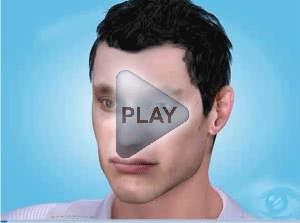 Conditions & Diseases - Lid hygeine Blepharitis is an inflammatory condition of the eyelids. Material secreted by the eyelids builds up on the lid margin and they become red and sore. Regularly cleaning the eyelids will help. Add baby shampoo to water (1:10) which has been boiled and left to cool until warm. Clean your hands, then apply cotton wool pads dipped in the solution to the eyelids. Leave for several minutes to loosen the material, repeating with a fresh the pad. Then take a cotton bud and dip it into the solution. Gently rub the cotton bud across the upper and lower eyelid margins, removing the debris. Repeat the process, ensuring you use a fresh cotton bud each time. Carryout this process regularly and the condition should improve. |
 Conditions & Diseases - Cataracts condition In a normal eye, light is focussed by the cornea and the lens... ... to form a sharp image on the retina at the back of the eye. As we get older, the lens can become hazy. This is known as a cataract. This makes the vision rather blurred or hazy ... ... even when wearing the correct spectacles. |
|
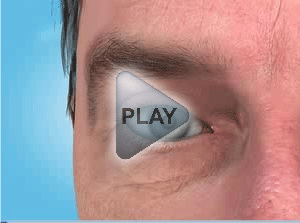 Conditions & Diseases - Cataracts treatment As we get older, the lens in the eye can become cloudy - a condition known as cataract. A cataract is a bit like a "dirty window" which makes everything look rather blurred or hazy. In most cases, vision can be restored by a simple operation. The eye is numbed and a special tool is used. This tool removes the cloudy part of the lens. A plastic lens designed for your eye is made. This is rolled up so that it can be inserted into the eye ... ... and placed in the lens capsule, where it springs into position. Usually, the new clear window greatly improves the quality of vision. |
 Conditions & Diseases - Colour vision deficiencies Light entering the eye consists of many different wavelengths. The light is absorbed by tiny cells at the back of the eye called cones. In a normal eye there are three different types of cones. Some cones are best at capturing long wavelength (red) light. Other cones catch medium wavelength (green) light ... ... while other cones respond best to short wavelength (blue) light. The signals from these cones are sent to the brain where they are perceived as colour. Some people are born with one or more cone types absent or "different". This can lead to difficulties differentiating between certain combinations of colours. Colour vision deficiencies can be detected and graded using various colour vision tests. |
|
 Miscellaneous - Eye anatomy 2 A horizontal cross-section of the eye. |
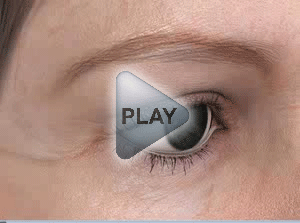 Conditions & Diseases - Diabetic retinopathy Diabetes can have various affects on the eyes, most commonly the retina. The walls of the blood vessels tend to become weakened. Over time, the walls may bulge - known as an aneurysm. This creates an 'eddy' in the blood flow which can eventually block. Blood and other fluids also tend to leak from the blood vessels. This results in a build up of lipids in the layers of the retina. Because of the reduction in blood flow, new blood vessels tend to form. However these blood vessels are fragile and bleed easily. If the new blood vessels bleed into the jelly in the eye (the vitreous)... ... there can be a sudden loss of vision. But this may clear somewhat over time. |
|
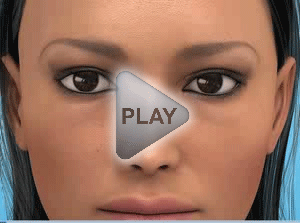 Conditions & Diseases - Dry eyes When we blink, the tears lubricate, nourish and protect the front of the eye. Tears have three main components: The lachrymal gland produces a watery component ... ... glands in our eyelids produce an oily component, while other cells produce a mucus. These mix together to create a film which covers the white of the eye and the cornea. When we blink, the film is wiped across the eye by the eyelids. If insufficient tears are produced or the constituents are out of balance ... ... it can result in sore, dry eyes. Wearing glasses or sunglasses can help to reduce tear evaporation. Instilling artificial tears can also help. In some cases, the tears can be kept in the eye for longer by plugging the tear ducts. |
 Conditions & Diseases - Glaucoma When light hits the back of the eye, tiny cells convert the light into nervous impulses. These travel across the retina, through the optic disc, to the brain. Glaucoma is a group of diseases which cause these nerves to become damaged. When this happens the nerves become unable to send the impulses ... ... which leads to blind spots, initially out of the corner of the eye. If the condition is not treated, the blind spots get larger and can lead to blindness. It is known that pressure in the eye is an important factor in this condition. The production and drainage of "water" in the front of the eye affects the pressure. If this gets out of balance the pressure in the eye can increase. Glaucoma can be controlled by using eye drops to reduce the pressure in the eye. |
|
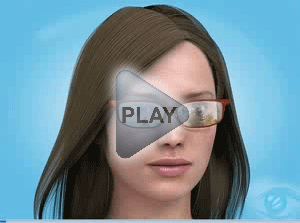 Spectacle dispensing - Anti-reflection Reflections from lenses make them more noticeable. Internal refractions within the lens ... ... can result in distracting reflections and "ghosting". These are particularly noticeable in bright sunshine or driving at night. Also, bright objects behind you can be reflected back into your eye ... ... creating a distracting double image. These reflections can be reduced by applying a special anti-reflection coating to the lens. This not only makes the lenses look more transparent ... ... but also helps to get rid of distracting reflections. It can also be beneficial when driving, particularly at night. |
 Spectacle dispensing - Bifocals Most people over the age of about 45 who wear glasses for distance ... ... gradually find it more difficult to focus on near objects. Reading becomes more difficult and they also require reading glasses. These are great for reading, but make everything in the distance blurred. One solution is to wear bifocal lenses. The top of the lens allows you to see in the distance ... ... while the bottom of the lens gives you clear near vision. This gives you clear distance and near vision in one pair of glasses. | |
 Miscellaneous - Eye anatomy 3 vertical cross-section of the eye. |
 Spectacle dispensing - Ready readers You can buy "ready-made" reading glasses in many shops. However, the frames are mass produced and so may not fit you very well. They assume that the distance between the eyes is the same for everyone ... ... so the lenses may not be correctly aligned with your eyes. They contain a "simple" prescription ... ... which is unlikely to be exactly right for your eyes. They have the same lens for each eye ... ... but many people require a slightly different lens for each eye. Glasses made specifically for you will offer more comfort and give you better vision. |
|
 Spectacle dispensing - Polarised Polarised lenses not only reduce glare like normal sunglasses ... ... they also have the special property of cutting out reflections from shiny surfaces. They are ideal if you like spending time near water. They are also great for driving ... ... reducing reflection from the bonnet and dashboard ... ... and wet roads. The polarised lens is sandwiched between two layers of material ... ... and the lens made to prescription. |
 Spectacle dispensing - Photochromic Light from the sun contains a spectrum of wavelengths. We can see some wavelengths - the visible spectrum ... ... but we cannot see wavelengths such as infra-red and ultraviolet (UV) light. There is good evidence that too much UV light can damage the eyes. In particular, a small area of the retina called the macula can be damaged ... ... which affects the ability to read and see small detail. Excessive exposure to UV light can also cause the lens in the eye to go hazy - cataracts. Photochromic lenses automatically adjust according to the brightness of the light ... ... changing from almost clear to a full sunglass tint in the sun. This provides comfortable vision under all conditions and excellent protection from UV. |
|
 Spectacle dispensing - UV protection Light from the sun contains a spectrum of wavelengths. We can only see light over a small range known as the visible spectrum ... ... but cannot see the infra-red and ultraviolet (UV) light outside the visible spectrum. There is good evidence that excessive exposure to UV light can damage the eyes ... ... in particular, a small part of the retina called the Macula. Too much UV can also make the lens in the eye go hazy - a condition known as cataract. A special coating can be applied to spectacle lenses which helps to block the UV light ... ... providing extra protection for your eyes. |
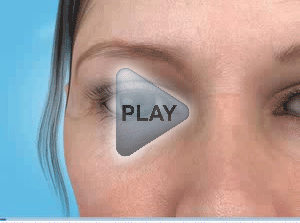 Conditions & Diseases - Detatched retina The eye is filled with a jelly-like substance know as the vitreous. The vitreous is loosely attached to the retina at the back of the eye. The retina is quite fragile and can tear. This may happen spontaneously or following a blow to the eye or head. As the retina tears, flashing lights are often seen - usually out of the corner of the eye. If this is not treated, fluid can pass through the tear ... ... and cause a larger area to become detached. This can lead to a permanent loss of vision if not treated straightaway. A tear or a detachment often causes a sudden increase in the number of floaters. |
|
 Contact lenses - Inserting soft Carefully remove a lens from its case, ensuring you select the correct lens for each eye. Place the lens in the palm of your hand and add a little soaking solution. Place the lens on your forefinger and look at the shape of the lens from the side. This lens is inside out - note the shape of the lens at the edges. This lens is the correct way round. Using the second finger of one hand, gently raise the upper eyelid. Using the second finger of the other hand pull down the lower eyelid slightly ... ... and gently place the lens onto your eye. |
 Contact lenses - Removing soft Before removing the lens, thoroughly wash your hands. Look straight ahead and pull down the lower eyelid with your second finger. Place your index finger on the lens ... ... and slide it onto the white part of the eye. Pinch it off between your thumb and index finger |
|
 Contact lenses - Caring soft Always wash your hands thoroughly and use a lint-free cloth to dry them. Remove a lens and place it in the palm of you hand. Add a small amount of all-in-one solution ... ... and gently rub the lens in a circular motion for a few seconds to remove any deposits. Rinse the lens, place in a clean case and add some all-in-one solution. Replace the lid and the lenses will be ready for the next time you wear them. |
 Contact lenses - Inserting RGP Remove the lens from the case, ensuring you select the correct lens for each eye. Place the lens in the palm of your hand and add a little wetting solution. Place the lens on the tip of your forefinger. Using the second finger of one hand raise the upper eyelid. Using the second finger of the other hand pull down the lower eyelid ... ...and gently place the lens onto your eye. |
|
 Contact lenses - Removing RGP Wash your hands thoroughly before removing your lenses. For your left eye, place the forefinger of your left hand at the corner of your eye. Place your right hand below the eye ready to catch the lens. Watch again ... Stare wide and with your left forefinger pull the eyelid towards your ear ... ... then blink. The lens should just pop out of your eye. |
 Caring RGP - Contact lenses Wash your hands thoroughly and dry them with a lint-free cloth. Every time you remove your lenses, place the lens in the palm of you hand ... ... and add a small amount of cleaning solution. Gently rub the lens in a circular motion for a few seconds to remove any deposits. Rinse the lens with solution and then place the lens in a clean case with more solution. Replace the lid and your lenses will be ready to be worn another day. |
|
 Contact lenses - Options for presbyopes Contact lenses give great distance vision. However, as we get older it becomes more difficult to see close up through the lenses. One option is to simply wear reading glasses over your contact lenses. However, when you look up, your distance vision will be blurred. Another option is to have one contact lens for distance and the other for reading. The brain selects the clearer eye giving clear distance and near vision. A third option is to wear multifocal contact lenses. These lenses have a distance and reading portion in one lens ... ... allowing you to see in the distance and to read. |
 Spectacle dispensing - Progressives Most people over the age of 45 who wear glasses for distance ... ... have increasing difficulty focussing on near objects. You need longer arms! One solution is to wear plain reading glasses. These are great for reading, but when you look up, everything in the distance is blurred. Bifocal lenses partly solve this by having a distance and a reading portion in one lens. However, some people do not like the visible appearance of the two lenses ... ... and objects at mid distances may still be blurred. Progressive lenses are much more attractive to look at ... ... and give clear vision over a range from distance to close up. |
|
 Spectacle dispensing - Lenses for high hypermetorpes Normally light is focussed on the retina at the back of the eye to form a sharp image. Long-sightedness means the eye is too short and the light is focussed beyond the retina. Lenses to correct this are thicker in the middle than at the edges. In a strong prescription, the lenses can be particularly heavy and unsightly. There are various ways to improve the appearance and minimise the weight of the lenses. Choosing a small frame will help minimise the weight. Secondly, consider lenses with a higher "refractive index". This will also reduce the thickness and weight of the lenses. Choosing lenses with an aspheric design will reduce the thickness further still. Anti-reflection coatings can also improve the appearance and your vision through them. |
 Spectacle dispensing - Lenses for myopes Normally light is focussed by the cornea and the lens to form a sharp image on the Retina. Sometimes the eye ball is too long and the light comes to a focus before the retina. Lenses to correct this are thicker at the edges than in the middle. In a stong prescription, the edges can be particularly thick and unsightly. There are a number of ways to avoid this. Choosing a small frame reduces the edge thickness and weight of the lens. Lenses with a high "refractive index" also reduce the edge thickness and weight. The third way is to use aspheric lenses which reduce the thickness further still. Anti-reflection coatings can also improve the appearance and vision through the lenses. |
|
 Laser surgery - LASEK Anaesthetic drops are used so that you will not feel anything throughout the procedure. A ring is placed over the eye into which alcohol is added for a few seconds. This detaches the outer layer of cells of the cornea ... ... allowing this layer to be peeled to one side, exposing the middle layers of the cornea. A computer-controlled laser is then focussed onto the cornea ... ... which quickly and painlessly re-shapes the cornea to correct your prescription. The outer layer of the cornea is then replaced ... ... and a "bandage" contact lens inserted to protect the cornea while it heals. LASEK can be used to correct long and short sightedness |
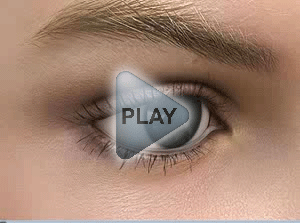 Laser surgery - LASER Refractive In a normal eye, light is focussed by the cornea and lens ... ... to form a sharp image on the retina at the back of the eye. Short-sightedness occurs when the eye is too long ... ... so that the light comes to a focus in front of the retina. Long-sightedness occurs when the eye is relatively too short. To correct short-sightedness, a laser is used to flatten the cornea slightly. For long-sightedness the laser is used to make the cornea a little steeper. Laser surgery can be used to correct most prescriptions including astigmatism. |
|
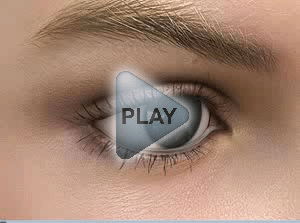 Laser surgery - LASIK Anaesthetic drops are used so that you will not feel anything throughout the procedure. A special device is used to create a very thin flap in the cornea. The flap is peeled back to expose the middle layers of the cornea. A special computer-controlled laser is then focussed on the exposed area. This quickly and painlessly re-shapes the cornea to correct your prescription. The flap is then carefully replaced and heals naturally. Drops may be used for a few days after treatment to minimise the risk of complications. LASIK is a type of laser surgery designed to correct short and long-sightedness. |
 Miscellaneous - Eye anatomy 1 The anatomy of the eye. |
|
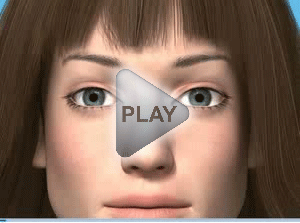 Miscellaneous - Vision pathway This sequence explains the way in which the brain processes vision. Images are processed at the back of the brain, on both sides. When looking straight ahead both sides of the brain are active. Images to the left are managed by the right hand side of the brain ... ... from BOTH eyes! And vision to the right by the left hand side of the brain. |
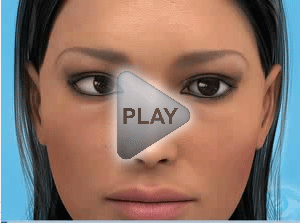 Binocular vision disorders - Squint treatment A squint occurs when the two eye are slightly misaligned. There are a number of things that can be done to help straighten the eyes. Sometimes eye exercises can help ... ... by strengthening the eye muscles. In some cases, glasses can help. In other cases, an injection or surgery may be indicated. |
|
 Binocular vision disorders - Phorias treatment Phorias can cause eye strain, headaches or occasional double vision. If this happens, eye exercises may help to strengthen the muscles. Your eye specialist will recommend the best type of exercises for your eyes. This may help to relieve the eye strain and headaches. In other cases, glasses may be required to correct the problem. |
 Spectacle dispensing - Vocational progressive If you require glasses for looking in the distance ... ... as you get older, you may require a different pair for reading. In many jobs it is impractical to keep swapping between two pairs of glasses. Bi-focals may be a solution, giving clear distance and near vision in one lens. However, they are not ideal for computer work which is mid-distance. You have to tilt your head back and lean forward to look through the reading lens. You may also have to move your head from side to side to see the entire screen. Vocational progressive lenses are designed to overcome these problems. These will give a wide area of clear vision for distance, viewing the screen and reading ... ... and will help improve posture and reduce back ache and headaches. |
|
 Miscellaneous - Working with computers Here are some simple things you can do to avoid getting "eyestrain". If possible, position your screen at right angles to the window ... ... and avoid too much light falling on the screen. Set your screen so that it is lower than your eyes ... ... this will help prevent your eyes getting too dry. Look away from the screen every ten minutes or so and blink a few times. Every hour or so, move away from your computer and have a break. |
 Miscellaneous - Eye anatomy 4 The relative position of the eyes to each other. |
|
 Miscellaneous - Eye anatomy 5 The inside of the eye. |
 Miscellaneous - Eye anatomy 6 The position of the eyes relative to the brain. |
|
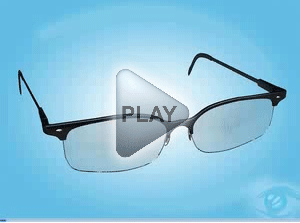 Spectacle dispensing - Scratch resistance Plastic lenses are nice and light but do tend to scratch quite easily. These scratches will reduce the quality of your vision through the lenses ... particularly under some conditions - like driving at night. To help protect your lenses, a thin coating can be applied to the lenses. This will help to keep your lenses in tip-top condition for much longer. |